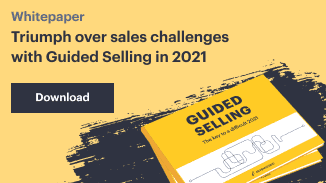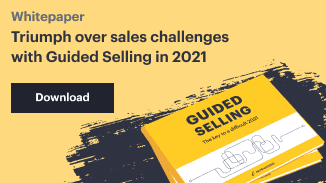Pitching can be rough.
Not only do you need to present your product, service and value prop in a matter of seconds, you also need to save some space for empathy and connection.
What is a sales pitch?
A sales pitch, or an elevator pitch, is a brief presentation where you give your customer an explanation of the nature and benefits of your business. Ideally, you should be able to deliver a sales pitch within the time constraints of a single elevator ride.
Why is a sales pitch important?
Whether you’re cold-emailing or following up on a call, there’s a lot to cover in very little time.
Without a plan, sellers often ambush buyers with an unsolicited lecture, an impersonal email or a generic elevator pitch. Of course, none of these things align with today’s relationship-style selling.
Let’s look at what makes a sales pitch effective and go over a few examples to help guide the way.
How to make a sales pitch: essential “ingredients” to know
Effective sales pitches are dynamic, they address buyer needs and, most importantly, they start a conversation.
To be successful, you’ll need to relate to your prospects — which means taking the time to learn about the buyer and coming up with a way to explain the value of your solution.
Only 13% of B2B buyers feel that salespeople truly understand their needs when trying to sell them on a solution.
Before you start putting together your pitch, make sure you have a clear understanding of the following:
- What are you selling?
- Who are you selling to?
- What makes you uniquely qualified to help this prospect?
- Do you have mutual connections?
- Is this person already familiar with your company?
Now that we’ve established a few basics, let’s look at some sales pitch examples that will help you close more deals.
Sales Pitch Example 1: Turn sales insights into a compelling story
At this point, you’ve already defined the who, what and why behind your sales pitch.
Your next move is to shape it into a compelling narrative where the buyer is the protagonist.
According to one study, 63% of prospects remember stories more than a dry list of facts.
Stories make B2B interactions seem more human and increase likeability, plus they help the prospect imagine the possibilities offered by your solution.
A good story contains the following elements:
- Character. Who is your target audience? What are their interests? What do they do?
- Problem. What challenges is this buyer facing now? Are they wasting too much time on spreadsheets? Are they having trouble making sense of increasingly large data sets?
- Solution. How can you help? Does your company simplify data analysis or automate time-wasting tasks?
- Success. What does success look like for your prospect? Here, you’ll want to address benefits by focusing on specific ways your product/service will improve their life. For example, will your automation solution free up time they get to spend with their family? Will the insights you provide help them make more money?
Now, remember, this isn’t a novel. It’s more of a teaser aimed to entice prospects into learning more. You’ll want to save the good stuff for later — after you’ve set the scene and done some character building.
Once they’re hooked, that’s when you can go in for the close.
Sales Pitch Example 2: Cold pitching via email
A great email sales pitch begins with a great hook, or subject line. If you fail to capture your prospect’s attention here, they’ll never know how great your offer is.
According to Convince and Convert, 35% of email recipients open emails based on subject line alone.
Here’s an example of how you might reach out to a new prospect via email.
Hi [Name],
I hope this email finds you well!
I’m reaching out because [mention how you got their contact info–mutual acquaintance, referral or through your own research].
[Your company] offers [solution] that can help your team do A, B and C.
We do this by:
- Benefit
- Benefit
- Benefit
I’d love to discuss more ways we can help [prospect company] get X results.
What time works best to set up a quick call [time and date]?
Best,
[Name]
Notice that this email starts by mentioning specific details about how the sender got the prospect’s contact information and why they’re reaching out.
As you put together your cold email templates, keep in mind, these personal details help warm things up.
Sales Pitch Example 3: Following up on a trigger action
A trigger action is something like an e-book download or signing up for an email list.
While you may be targeting someone you’ve never talked to before, this person is at least somewhat familiar with your brand.
Here, you’ll want to make sure that your pitch lines up with what’s expected at this stage in the buyer’s journey.
For example, you might follow up after a prospect downloads a case study with something like this:
“Hi [Name],
I noticed that you downloaded X case study from my previous email and thought I’d check back in.
Did you get a chance to look over my original proposal?
I’d be happy to go over key features over the phone and answer any questions you might have.
What time works best for a 15-minute call?”
Set up triggers to follow up on key actions your prospect does with Revenue Grid. Ask us how:
This email serves the same purpose as those “just checking in” messages everyone hates. The reason this works is, you’re using prospect engagement as a reason for reaching back out.
Because downloading a case study or industry report indicates interest, it’s worth circling back to see if the prospect is ready to move forward after doing some research.
If you’re reaching out post-download to someone new, you might use your initial email to gauge interest before launching into a pitch.
Try something short and sweet like this to make contact:
Hello [Name],
What was driving your interest in [Solution]?
I will plan to give you a call a bit later — when is the best time for us to connect?
Sincerely,
[Name]
While this isn’t a full-on pitch, the seller sets the stage for a two-pronged approach.
If the recipient responds, the seller gains a bit more insight into how to present the solution when he follows up.
Sales Pitch Example 4: Cold calling sales pitch example
If you’re cold calling, doing your research becomes even more important.
“Rep: Hey Jane, it’s John from X Company. How are you?
Prospect: Not bad, what can I help you with, John?
Rep: I came across a handful of Google Ads campaigns promoting Product A, and believe you could boost your conversion rate by making some changes to your landing pages.
Prospect: Sorry, what do you guys do?
Rep: We help brands like X and Y improve their conversion rates by managing PPC and paid social media campaigns.
In fact, X client saw [insert impressive stat] after working with us for just three months.
Prospect: Hmm..
Rep: I’d love to learn more about your strategy and share some ideas that have worked well for brands like X and Y.
Do you have time for a short call next week?”
So, the reason this approach works is, it kicks off with a great opening line. The seller doesn’t resort to the dreaded, “is this a good time to talk about X product?”
Instead, they use a bit of small talk to get a read on the prospect’s mood.
Additionally, the seller keeps moving, even as the prospect drops an “I’m sorry, what do you guys do?”
Sales Pitch Example 5: Build trust by outlining your goals for the call
Prospects are often wary of getting trapped in a high-pressure conversation with a strange sales rep.
Setting an agenda for the call is an effective way to demonstrate to prospects that their time is valuable. If you’re reaching out cold, it helps you convince the buyer to hear you out.
Here’s an example that gives prospects a sense of what to expect on the call.
“Hi [Name], glad we were able to connect today. I’d like to go over A, B and C, and then we can go over any questions you might have. Does that sound good to you?”
Here, you’ll want to make sure that each item on the agenda speaks to something your prospective buyer cares about–stick to 3-5 key points and arrange them in a logical order.
It’s also worth noting that this agenda-setting tactic works really well for demos or other types of scheduled calls.
Sales Pitch Example 6: Follow-up sales pitch examples
Given today’s long sales cycles and multi-buyer decision-making processes, it’s no surprise that few deals close on the spot, yet many sellers give up without a fight.
Studies show that 92% of sales reps give up after the first ‘no’, but four out of five prospects will say ‘no’ four times before saying ‘yes’.
Another study found that 70% of email conversations end when a prospect doesn’t reply to the first email. That same study also found a 21% chance that prospects will respond the second time around.
Here are a couple of ways to break through to prospects and get a response.
Follow up on a voicemail
The voicemail-email combo is a classic sales tactic for staying fresh in buyers’ minds. For this to work, you’ll need to follow-up with an email minutes after leaving the voicemail.
Try something like this:
Subject line: Just tried to call you
“Hi [Name],
I just tried to call you but assume you’re busy. Please give me a call back at [number] or respond to this email to set up a better time to chat.
Look forward to hearing from you soon.
Best,
[Name]”
Following up on an unopened email
In this case, you can reuse most of the content from your original message.
I recommend adding a quick reference to the original email so that the recipient doesn’t assume you’ve copied and pasted the exact same message.
“Hi [Name],
I’m following up on my last email as I wanted to make sure you were aware of [offer].
[Insert text from original message]”
In this scenario, you might want to switch up your subject line, as the original copy may not have been compelling enough to warrant a click.
Sales Pitch Example 7: Don’t forget the close
Whether it’s a cold call or a follow-up email, every pitch should end with a clear next step.
While this may seem like sales 101 stuff, an estimated 85% of salespeople don’t ask for the sale.
Big mistake.
Another report found that roughly 90% of buyers won’t buy unless a salesperson explicitly asks them to, so it’s safe to say that leaving things on an open-ended note won’t get you any closer to hitting your quota.
Here are a few examples for how you might work that critical call-to-action into your next sales pitch.
Book a demo
“You can book a demo on my calendar – I’ll show you how to do [X, Y and Z].
What projects are you working on? How many people are on your team?”
Best,
[Name]”
The goal in this email is to get the buyer to book a demo (by the way, you can schedule meetings with Revenue Grid, which syncs meeting details across all connected sales tools) is part of, while the additional questions at the end provide an opportunity for the rep to learn more about the buyer’s needs.
Promote a Download
“If you have any questions about [Company Name], feel free to reach out–I’m happy to help.
If you haven’t already, take a look at [Resource] you can access it here.
The report offers tons of valuable insights that can help you with X and Y.
Best,
[Name]”
Conclusion
Learning how to make a sales pitch is a competitive advantage.
Not only can it help you stand out amongst your competitors, it’s also a step toward building connections that lead to more sales.
Remember, your sales pitch should focus on individual buyers’ needs and place the prospect at the center of the story.
With Revenue Grid, keeping every story straight is easier than ever.
Guided selling tools help reps choose the best pitching tactics for any selling situation, while bringing Salesforce into the inbox for more context.



